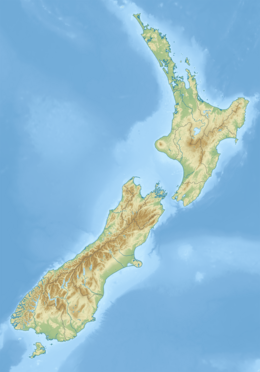Matapara / Pickersgill Island
Native name: Matapara (Māori) | |
|---|---|
 Matapara / Pickersgill Island, as seen from Arapaoa Island in 1902 | |
| Geography | |
| Location | Queen Charlotte Sound / Tōtaranui |
| Coordinates | 41°09′48″S 174°17′04″E / 41.1632°S 174.2845°E |
| Archipelago | Marlborough Sounds |
| Adjacent to | Cook Strait |
| Length | 1.68 km (1.044 mi)[1] |
| Width | 1.3 km (0.81 mi)[1] |
| Highest elevation | 186 m (610 ft)[1] |
| Administration | |
Matapara / Pickersgill Island (Māori: Matapara) is an island in New Zealand's Marlborough Sounds, in the outer reaches of Queen Charlotte Sound / Tōtaranui. The island is separated from Cook Strait by nearby Arapaoa Island, however this offers little protection for Matapara from the prevailing northerly wind.[2]
In 2014, the island was granted a dual name as part of a Treaty of Waitangi claims settlement with the Te Āti Awa iwi, with each portion of the name signifying the island's history. James Cook named the island in 1770 during his first voyage in honour of Richard Pickersgill, a Master's mate on HMS Endeavour at the time.[3] Te Āti Awa have referred to the island as Matapara since their 1828 conquest of Tōtaranui and Kura Te Au, as part of an alliance with Tainui and Taranaki Māori.[4] For Te Āti Ara and other iwi in the region, Matapara was a key strategic holding, with a defensible position and food sources. Portions of the island remain Wāhi Tapu (sacred sites) for local Māori to this day.[5]
As with other offshore islands in New Zealand (such as nearby Blumine Island / Ōruawairua), work is underway on Matapara / Pickersgill Island to eradicate introduced pests and provide a sanctuary for native wildlife. Rats were previously eradicated from the island in 2005 by the Department of Conservation (DOC), however Matapara's proximity to nearby Arapaoa Island means that rats were able to re-introduce themselves.[6] Current conservation efforts are supported by local sailing clubs alongside DOC, and have facilitated the island becoming regionally significant for its high perceived naturalness, including its flora and fauna.[7]
References
[edit]- ^ a b c "NZTopoMap: Matapara". NZTopoMap. Land Information New Zealand. Retrieved 27 November 2021.
- ^ "Queen Charlotte Sound Cruise Guide". cruiseguide.co.nz. Steven Williams Publications. Retrieved 27 November 2021.
- ^ "Tuia – Encounters 250: Cook's place names around New Zealand - Endeavour Inlet". linz.govt.nz. Land Information New Zealand. Retrieved 27 November 2021.
- ^ Raukura Consultants. "Cultural Impact Assessment: Waitohi Picton Ferry Precint Re-Development" (PDF). epa.govt.nz. Te Ātiawa o Te Waka A Māui. Retrieved 27 November 2021.
- ^ "Place name detail: Matapara / Pickersgill Island". New Zealand Gazetteer. New Zealand Geographic Board. Retrieved 28 November 2021.
- ^ Trigger, Sophie (18 December 2019). "Mana Cruising Club sailing the Strait to keep Marlborough Sounds rat-free". Stuff.co.nz. Stuff. Retrieved 27 November 2021.
- ^ "Appendix 2: Values contributing to high, very high, very high and outstanding coastal natural character" (PDF). Marlborough District Council. Retrieved 27 November 2021.


